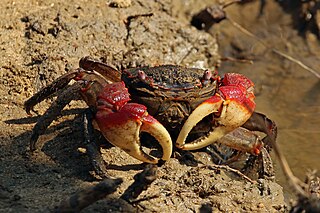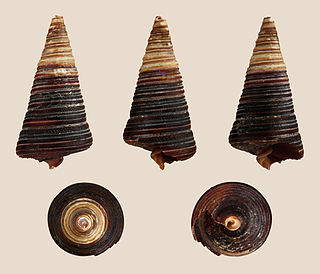 W
WThe lesser adjutant is a large wading bird in the stork family Ciconiidae. Like other members of its genus, it has a bare neck and head. It is however more closely associated with wetland habitats where it is solitary and is less likely to scavenge than the related greater adjutant. It is a widespread species found from India through Southeast Asia to Java.
 W
WThe anhinga, sometimes called snakebird, darter, American darter, or water turkey, is a water bird of the warmer parts of the Americas. The word anhinga comes from the Brazilian Tupi language and means devil bird or snake bird. The origin of the name snakebird is apparent when swimming: only the neck appears above water so the bird looks like a snake ready to strike. They do not have external nares (nostrils) and breathe solely through their epiglottis.
 W
WAratus pisonii, commonly known as the mangrove tree crab, is a species of crab which lives in mangrove trees in tropical and subtropical parts of the Americas, from Florida to Brazil on the Atlantic coast, and from Nicaragua to Peru on the Pacific coast. It feeds mostly on the leaves of the mangroves, but is an omnivore, and prefers animal matter when possible. A. pisonii is the only species in the monotypic genus Aratus. The specific epithet pisonii commemorates the Dutch naturalist Willem Piso who travelled in Brazil in 1638 with Georg Marggraf.
 W
WThe broad-snouted caiman is a crocodilian reptile found in eastern and central South America, including southeastern Brazil, northern Argentina, Uruguay, Paraguay, and Bolivia. It is found mostly in freshwater marshes, swamps, and mangroves, usually in still or very slow-moving waters. It will often use man-made cow ponds.
 W
WPirenella cingulata is a species of medium-sized sea snails or mud snails, marine gastropod mollusks in the family Potamididae, the horn snails.
 W
WThe fulvous whistling duck or fulvous tree duck is a species of whistling duck that breeds across the world's tropical regions in much of Mexico and South America, the West Indies, the Southern United States, sub-Saharan Africa and the Indian subcontinent. It has plumage that is mainly reddish brown, long legs and a long grey bill, and shows a distinctive white band across its black tail in flight. Like other members of its ancient lineage, it has a whistling call which is given in flight or on the ground. Its preferred habitat consists of wetlands with plentiful vegetation, including shallow lakes and paddy fields. The nest, built from plant material and unlined, is placed among dense vegetation or in a tree hole. The typical clutch is around ten whitish eggs. The breeding adults, which pair for life, take turns to incubate, and the eggs hatch in 24–29 days. The downy grey ducklings leave the nest within a day or so of hatching, but the parents continue to protect them until they fledge around nine weeks later.
 W
WIlyoplax is a genus of Crab.
 W
WJunonia evarete, the Tropical Buckeye or West Indian buckeye, is a Neotropical butterfly of the Nymphalids (Nymphalidae) family. It has characteristic eye spots on the wings, which have a wingspan between 4.5 and 6.5 cm. This butterfly is easily confused with Junonia genoveva, the mangrove buckeye. Not only have the common names mangrove and tropical buckeye been confused, but the butterflies themselves have been sometimes misidentified in past literature, because the two species have many variations, subspecies and seasonal forms, which makes it difficult to identify or differentiate. Phylogenetic studies demonstrate the separation of evarete and genoveva, but evidence suggests that subspecies and perhaps additional species await their descriptions within this group.
 W
WJunonia genoveva, the mangrove buckeye, is a butterfly of the family Nymphalidae. The species was first described by Pieter Cramer in 1780. It is found in North America from southern New Mexico, southern Arizona, southern Texas, and southern Florida south through the West Indies, Mexico and Central America to Argentina. Rare strays can be found up to southeastern California, southeastern Colorado and central Florida. In the Cayman Islands, it is known as the Caribbean buckeye.
 W
WJunonia evarete, the Tropical Buckeye or West Indian buckeye, is a Neotropical butterfly of the Nymphalids (Nymphalidae) family. It has characteristic eye spots on the wings, which have a wingspan between 4.5 and 6.5 cm. This butterfly is easily confused with Junonia genoveva, the mangrove buckeye. Not only have the common names mangrove and tropical buckeye been confused, but the butterflies themselves have been sometimes misidentified in past literature, because the two species have many variations, subspecies and seasonal forms, which makes it difficult to identify or differentiate. Phylogenetic studies demonstrate the separation of evarete and genoveva, but evidence suggests that subspecies and perhaps additional species await their descriptions within this group.
 W
WMangrove crabs are crabs that live among mangroves, and may belong to many different species and even families. They have been shown to be ecologically significant in many ways. They keep much of the energy within the forest by burying and consuming leaf litter. Along with burrowing in the ground, at high tide and in the face of predators these crustaceans can climb trees to protect themselves. The hermit crab and the mangrove crab are the only crustaceans that can climb trees as a defense mechanism. Furthermore, their feces may form the basis of a coprophagous food chain contributing to mangrove secondary production.
 W
WThe mangrove cuckoo is a species of cuckoo that is native to the Neotropics.
 W
WParasesarma leptosoma, also known as the arboreal crab, is an arboreal, leaf-eating mangrove crab, from East and South Africa where it is found on Rhizophora mucronata and Bruguiera gymnorhiza, but not on Avicennia marina. It occupies an ecological niche similar to that of another sesarmid, Aratus pisonii, from the Americas.
 W
WPirenella cingulata is a species of medium-sized sea snails or mud snails, marine gastropod mollusks in the family Potamididae, the horn snails.
 W
WTelescopium telescopium, or horn snail, is a species of marine gastropod molluscs in the family Potamididae. It is found in mangrove forests throughout the coastlines of the Indian Ocean.